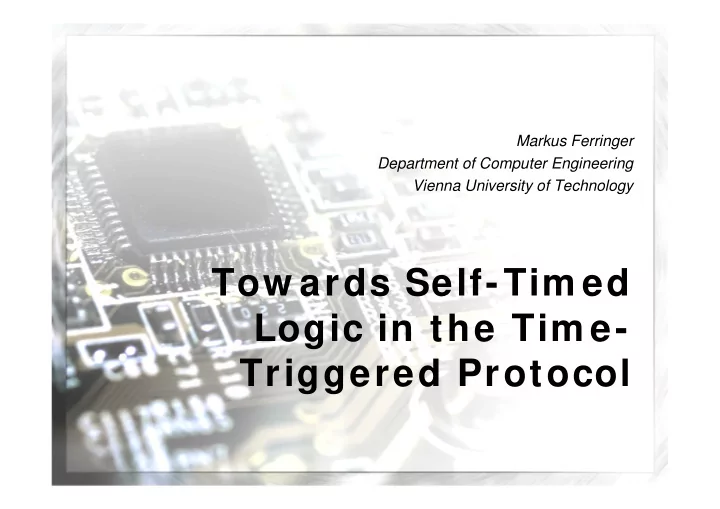

Markus Ferringer Department of Computer Engineering Vienna University of Technology Tow ards Self-Tim ed Logic in the Tim e- Triggered Protocol
Overview � Introduction � Project ARTS � Asynchronous design � Time-Triggered Protocol � System setup and architecture � Time-Reference Generation � Design alternatives � Comparison � Experimental results � Jitter and precision � Summary
Project ARTS � Asynchronous Logic in Real-Time Systems � Investigation of temporal predictability of asynchronous logic (QDI designs) � Data-dependent vs. random jitter � Changing operating conditions � Case study: Asynchronous TTP controller � Temperature / supply voltage influence delays � Dynamic adaption to varying execution speeds � Challenge: Accurate notion of time
Asynchronous Design � Level-Encoded Dual-Rail (LEDR) � Phased Logic: Two code sets � Exactly one rail changes (2-phase protocol) � Simple completion detection � (Quasi-)Delay Insensitive � Signal delays unconstrained � Timing assumptions hidden inside basic building blocks
The Time-Triggered Protocol � Highly reliable communication protocol for hard real-time systems � Fault-tolerance, consistency, dependability � Exploits a-priori system knowledge � Static message schedule � Time Division Multiple Access (TDMA) � Membership, global time, consistency, ...
System Setup � One asynchronous TTP controller embedded in synchronous system � Notion of time � Time reference derived from bit stream � Continuous resynchronization necessary � Known bit rate on bus � Manchester coding � Data clock encoded � At least 1 transition per bit
System Setup
Time Reference - Basic � Free-running, asynchronous counter � Reproduce duration by counting to ref-val � Continuous adjustment of ref-val one per frame
Time Reference - Advanced � Additional rate correction per received bit � Better accuracy: Less quantization error
Time Reference - LFSR � Incrementer/Decrementer replaced by LFSR � Changing shift direction equals “counting down” � Area and performance efficient � Only one XOR gate for a full period 15-bit LFSR � Propagation delay: One gate equivalent � Monotonic order of counting states not necessary for our purposes
Time Reference - Example � Basic (dashed) vs. advanced counter design � Early transition: Decrease ref-val (too slow) � Late transition: Increase ref-val (too fast)
Time Reference - Comparison Counter Advanced LFSR Gates 381 (100%) 230 ( 60%) Registers 52 (100%) 42 ( 80%) Performance 25ns (100%) 18ns ( 72%) Logic Depth 7 (100%) 6 ( 85%) Freq. Deviation 758ps (100%) 404ps ( 53%) � LFSR compared to Counter Advanced � Area efficient � High performance, lower logic depth � Low complexity => low frequency jitter
Time Reference - Jitter Counter: Jitter characteristic (ref-val) (ref-val) – 1 (ref-val)+1
Time Reference - Measurement LFSR: Temperature Tests (25 to 83 to 25°C)
Summary � Time-Reference Generation � Basic counter (measure SOF) � Additional rate correction per bit � Replace counters with LFSR � LFSR: Area and performance efficient � Precision � Jitter, quantization error � Automatic adaption to changing conditions � Temperature, Voltage
Recommend
More recommend